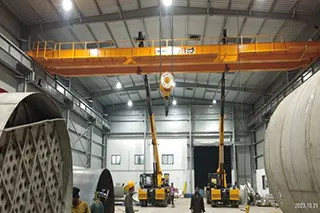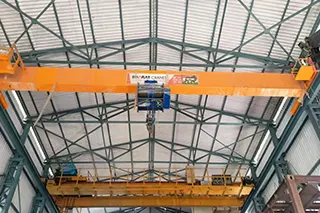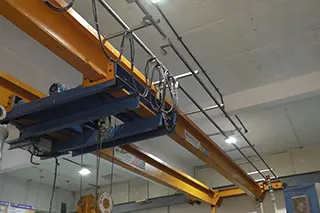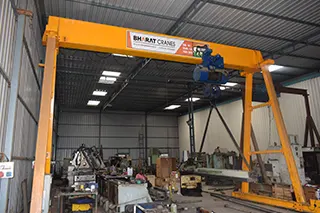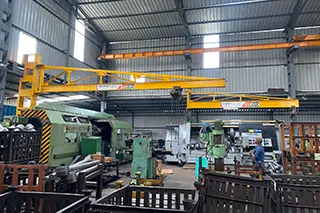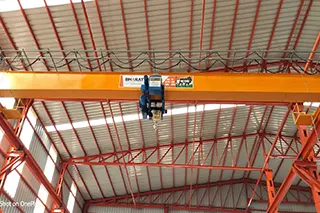Single Girder vs. Double Girder EOT Cranes: Which is the Best Fit for Your Requirements?
When selecting an Electric Overhead Travelling (EOT) crane, one of the most important decisions you’ll face is choosing between a single girder and a double girder design. Both types of EOT cranes are widely used across industries, but they serve different purposes and offer distinct benefits. In this blog, we’ll break down the differences between single girder and double girder EOT cranes, helping you determine which crane is best suited to your needs.
Understanding Single Girder EOT Cranes
A single girder EOT crane consists of a single horizontal beam (girder) that supports the hoist and trolley. The crane bridge is supported by end trucks, which move along a runway. Here are the key aspects of single girder EOT cranes:
Simplicity in Design: Single girder cranes have a straightforward design with a single beam, making them lightweight and easier to install. The reduced complexity results in lower costs, both for initial installation and long-term maintenance.
Cost-Effectiveness: If you are looking for a budget-friendly solution without compromising on performance, a single girder EOT crane is often the best choice. It’s ideal for light to moderate lifting requirements, typically up to 20 tons.
Efficient Space Utilization: The low headroom design allows single girder cranes to operate efficiently in spaces with limited vertical clearance. This makes them suitable for applications where overhead space is restricted.
Common Applications: Single girder cranes are widely used in industries like warehouses, manufacturing plants, and smaller workshops where moderate lifting capacity is needed.
Understanding Double Girder EOT Cranes
A double girder EOT crane features two parallel girders that provide support for the hoist and trolley, as implied by its name. This design allows for greater load capacity and enhanced lifting height. Here are the key characteristics of double girder EOT cranes
Heavy-Duty Lifting Capacity: Double girder cranes are designed for demanding applications. With two girders, they can handle much heavier loads, typically up to 500 tons. This makes them perfect for heavy industries like steel plants, shipyards, and construction sites.
Increased Lifting Height: Since the hoist is mounted on top of the girders, double girder cranes provide greater lifting height compared to single girder models. This feature is essential for operations requiring maximum vertical lift, such as moving heavy machinery or construction materials.
Longer Span and Greater Durability: Double girder EOT cranes can span wider distances and are built for durability in tough industrial environments. Their robust construction ensures a longer service life, even under constant heavy usage.
Advanced Features: With a double girder design, it is easier to incorporate advanced features such as walkways, maintenance platforms, or auxiliary hoists, making these cranes more versatile and adaptable to complex operations.
Key Differences Between Single and Double Girder EOT Cranes
Load Capacity:
Single Girder: Suitable for light to moderate loads, typically up to 20 tons.
Double Girder: Designed for heavy-duty applications, capable of handling loads up to 500 tons.
Cost:
Single Girder: More cost-effective in terms of both initial investment and maintenance.
Double Girder: Higher upfront cost due to the complex design, but essential for demanding lifting tasks.
Lifting Height:
Single Girder: Limited lifting height, suitable for low headroom spaces.
Double Girder: Greater lifting height, ideal for high vertical lift applications.
Installation and Maintenance:
Single Girder: Easier and faster to install with lower maintenance costs.
Double Girder: Requires more complex installation but offers added features like walkways and platforms.
Space Requirement:
Single Girder: More compact design, perfect for smaller workshops and restricted spaces.
Double Girder: Requires more space but offers greater versatility and durability for large industrial sites.
Which Crane is the Best Fit for Your Requirements?
Choosing between a single girder and double girder EOT crane depends on your specific operational needs. Here are a few key considerations:
Light to Medium Loads: If your operations involve light to moderate loads and your facility has space constraints, a single girder EOT crane is the ideal choice. It’s cost-effective, easy to install, and perfect for applications where lifting height isn’t a critical factor.
Heavy Loads and High Lifting Height: For industries that require heavy-duty lifting and maximum lifting height, a double girder EOT crane is the better fit. Although it comes with a higher price tag, its advanced features and ability to handle challenging tasks make it a worthwhile investment.
Budget Considerations: If budget is a significant concern and your operations do not demand heavy-duty lifting, a single girder crane is the most economical solution. On the other hand, if your business depends on high-performance lifting equipment, the investment in a double girder crane can lead to long-term productivity gains.
Conclusion:
Both single girder and double girder EOT cranes offer unique advantages depending on the operational needs of your business. If you’re looking for a cost-effective solution for light to moderate lifting, a single girder crane is an excellent choice. However, if your requirements involve heavy loads, increased lifting height, and more complex operations, a double girder crane is the best fit. By carefully evaluating your load capacity, budget, and space constraints, you can select the crane that provides the best value and performance for your specific needs.
